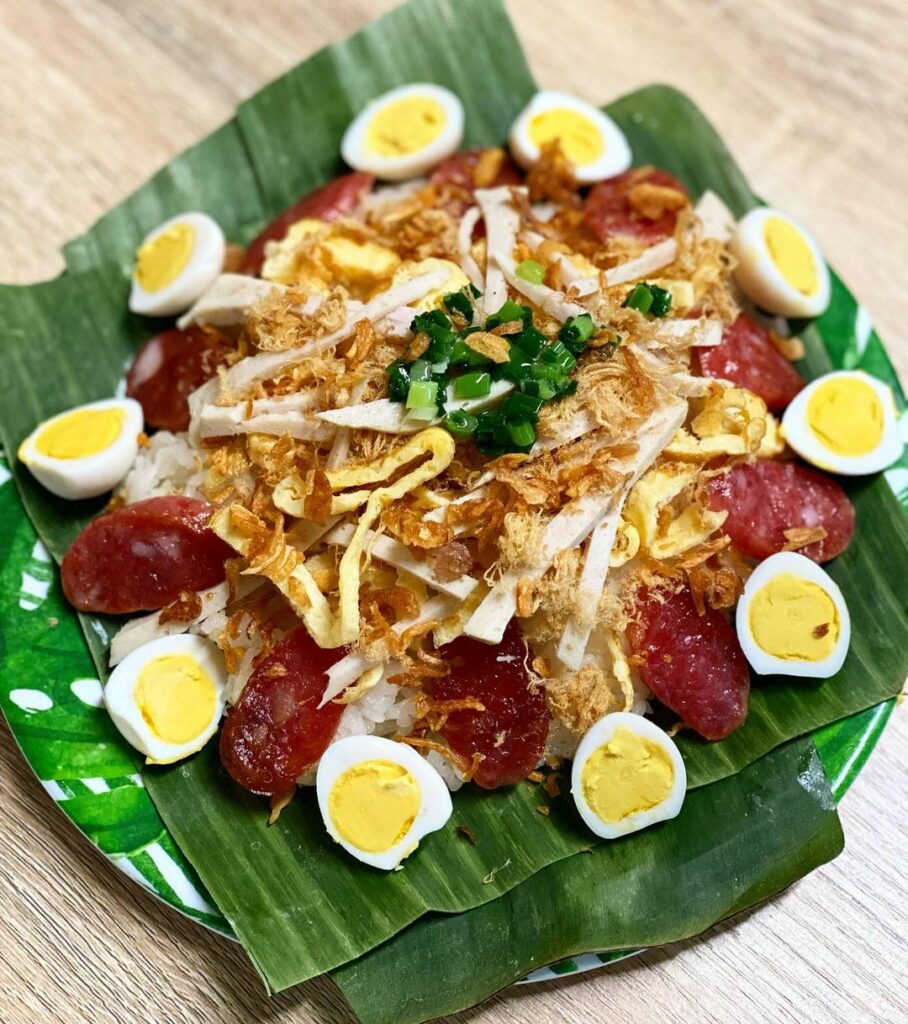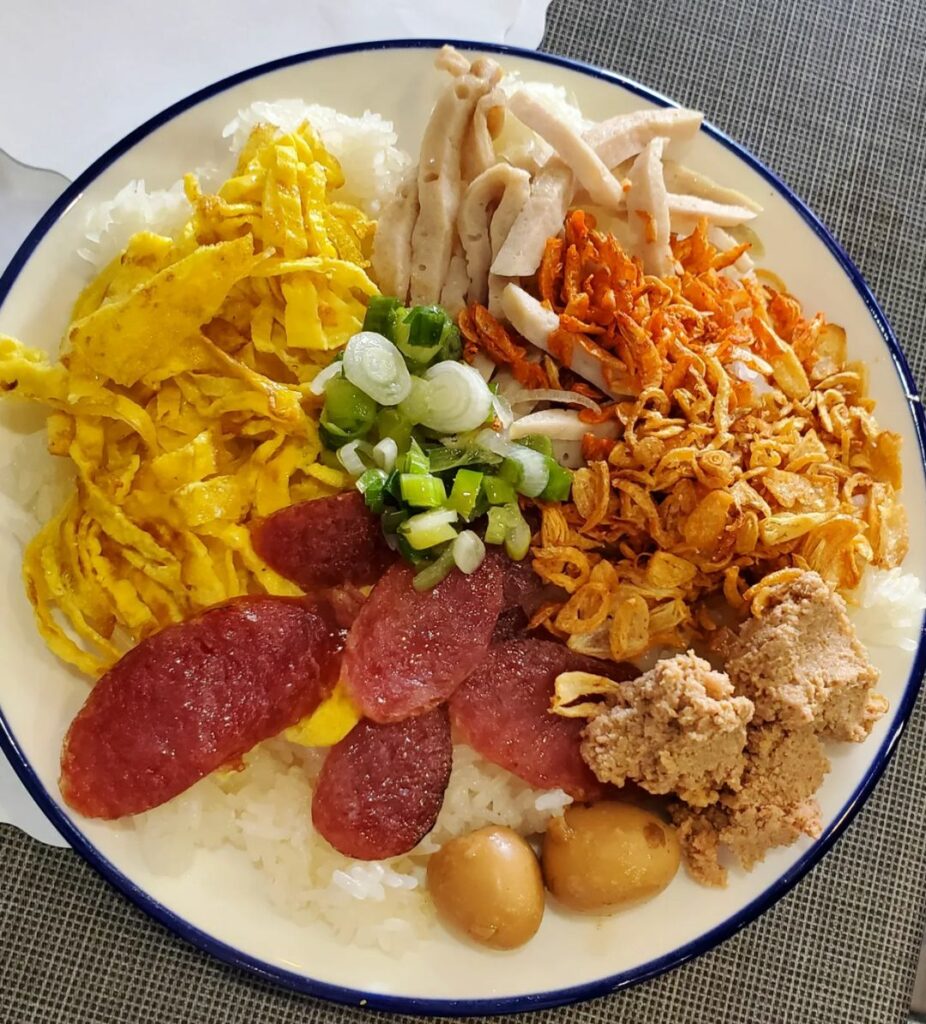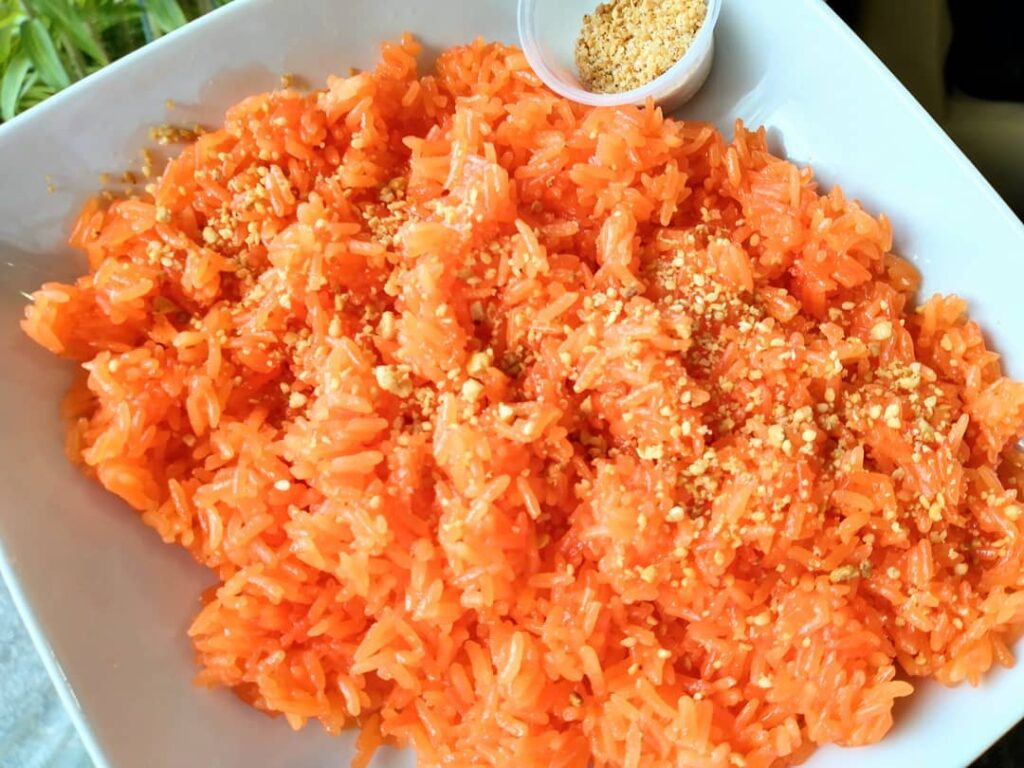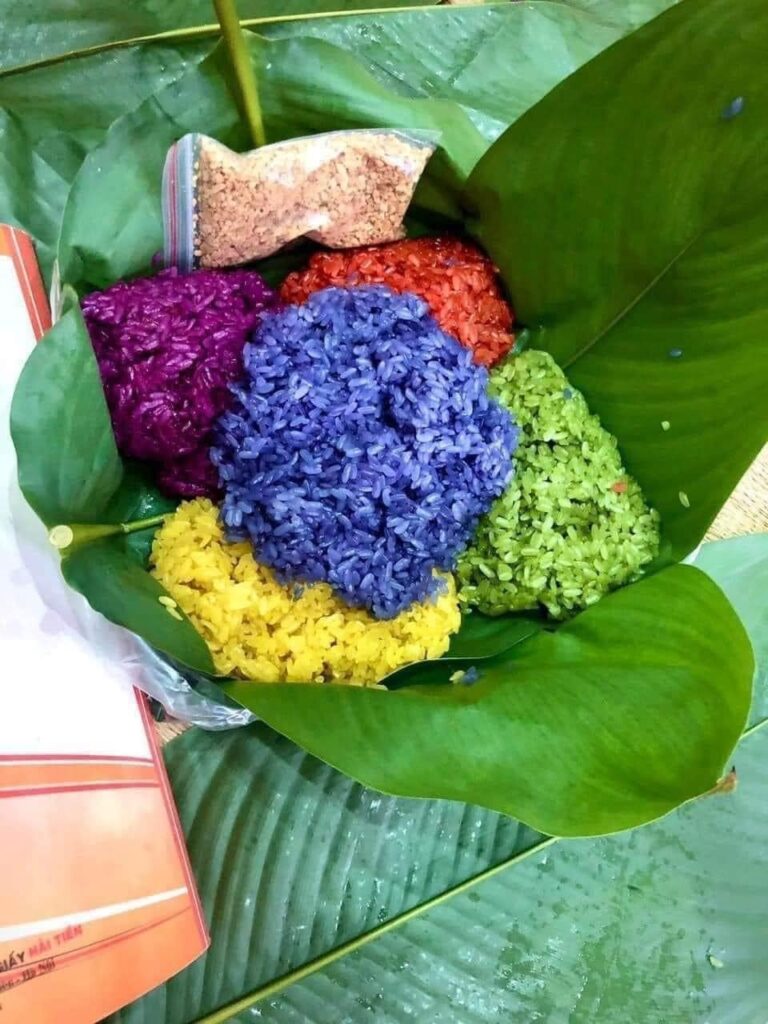Vietnamese sticky rice, a delightful and cherished culinary treasure, holds a special place in the hearts and palates of those who have savored its unique flavors. Known as “xoi” in Vietnamese, this humble dish transcends its simple ingredients to create a symphony of taste and texture. Its enticing aroma and sticky, glutinous texture make it a beloved staple in Vietnamese cuisine, enjoyed as a breakfast delight, a satisfying snack, or even a hearty main course.
From the traditional savory variations like Xoi Xeo and Xoi Man to the indulgent sweet renditions like Xoi Nep Cam and Xoi Lac, each bite of Vietnamese sticky rice offers a glimpse into the rich culinary heritage and vibrant flavors of this enchanting Southeast Asian nation.
Join me on a culinary journey as we explore the captivating world of Vietnamese sticky rice, where tradition meets innovation and taste buds dance in delight.
What is Vietnamese sticky rice?

Vietnamese sticky rice (Xoi), also known as glutinous rice or sweet rice, is a type of short-grain rice that becomes sticky when cooked due to its high starch content. This rice is a staple food in Vietnam, where it is used in various traditional dishes, both savory and sweet.
The history of Vietnamese sticky rice, and do you know where does sticky rice come from, can be traced back to the Dong Son culture, which existed in Vietnam around 2000 BCE. Back then, sticky rice was considered a luxury food and was only consumed by the royal family and the elite. However, as rice farming became more widespread in Vietnam, sticky rice became a common ingredient in Vietnamese cuisine.
Vietnamese sticky rice is deeply ingrained in Vietnamese culture and tradition. It is a symbol of prosperity and unity and is often served during special occasions such as weddings, funerals, and religious festivals. It is also a staple food in daily meals, often served with meat or vegetables, or as a filling in various types of cakes and desserts.
Sticky rice is not unique to Vietnam and can be found in other Southeast Asian countries such as Thailand, Laos, and Cambodia. However, each country has its own unique varieties and preparation methods.
Vietnamese sticky rice recipe

To make sticky rice Vietnam, you will need glutinous rice (also known as sweet rice or sticky rice) and a few basic ingredients. Here’s a simple Vietnamese sticky rice recipe to make authentic Vietnamese sticky rice at home:
Cooking note
- Yield: 4–6 servings
- Prep Time: 2 hours (including soaking time)
- Cook Time: 20-25 minutes
- Total Time: 2 hours 25 minutes
- Course: Main Dish, Side Dish, Breakfast
- Cuisine: Vietnamese
- Equipment: Steamer basket, large mixing bowl, pot with a tight-fitting lid
Ingredients
- 2 cups glutinous rice (also known as sweet rice or sticky rice)
- 2 1/4 cups water
- 1/4 teaspoon salt
- 1 pandan leaf (optional)
- 1 tablespoon vegetable oil (optional)
How to make Vietnamese sticky rice?
To cook Vietnamese sticky rice in the most delicious and fastest way, I will guide you step by step.
- Rinse the sticky rice in cold water until the water runs clear. Soak the rice in water for 1 hour or overnight. Drain the rice and let it sit in the colander for 10–15 minutes to remove excess water.
- In a large mixing bowl, combine the rice, water, salt, and pandan leaf (if using). Mix well and let the rice soak for another 30 minutes.
- Prepare your steamer basket by filling the pot with enough water to reach just below the bottom of the basket. Bring the water to a boil over high heat.
- Place the rice mixture in the steamer basket and level the top. Drizzle the vegetable oil (if using) on top of the rice. Place the basket over the pot of boiling water and cover it with a tight-fitting lid. Reduce heat to medium and steam for 20–25 minutes, or until the rice is tender and cooked through.
- Turn off the heat and let the rice sit in the steamer basket, covered, for 5–10 minutes to allow it to absorb any excess moisture. Fluff the rice with a fork and serve hot.
Comma mistake when making Vietnamese sticky rice
One common mistake when making Vietnamese sticky rice is not rinsing the rice thoroughly before soaking it. It’s important to rinse the rice in cold water until the water runs clear to remove excess starch, which can make the rice too sticky and clumpy.
Another mistake is not soaking the rice for long enough, as this can result in unevenly cooked rice or rice that is too dry or hard.
Lastly, not using a steamer basket or proper equipment can also lead to undercooked or overcooked rice.
Tips and tricks for perfect Vietnamese sticky rice
Here are some tips and tricks for making perfect Vietnamese sticky rice:
- Use the right type of rice: It’s important to use glutinous rice (also known as sweet rice or sticky rice) for this recipe. Regular long-grain rice will not work as it doesn’t have the same sticky texture.
- Rinse the rice thoroughly: Rinse the rice in cold water until the water runs clear to remove excess starch. This will prevent the rice from being too sticky or clumpy.
- Soak the rice for long enough: Soak the rice for at least 1 to 2 hours or overnight to allow it to absorb water and cook evenly.
- Use a steamer basket: Using a steamer basket is the best way to cook sticky rice, as it allows the rice to steam evenly and absorb moisture.
- Add pandan leaf for flavor (optional): Pandan leaf is a common ingredient in Vietnamese cuisine and can be added to the rice for extra flavor and aroma. If you can’t find pandan leaf, you can skip this ingredient.
- Fluff the rice after cooking: Once the rice is cooked, let it sit in the steamer basket for a few minutes to absorb any excess moisture. Then, fluff the rice with a fork to loosen any clumps and distribute the moisture evenly.
Nutritional value of Vietnamese sticky rice

Here is a table outlining the nutritional value of sticky rice Vietnam:
| Nutrient | Amount |
| Calories | 361 |
| Fat | 0.6g |
| Carbohydrates | 80g |
| Fiber | 1.2g |
| Protein | 6.7g |
| Thiamin (Vitamin B1) | 0.2mg |
| Niacin (Vitamin B3) | 2.6mg |
| Iron | 1.3mg |
| Magnesium | 82mg |
| Phosphorus | 135mg |
It’s worth noting that Vietnamese sticky rice calories are relatively high compared to regular rice, due to its higher carbohydrate content. However, sticky rice also contains essential nutrients like vitamins B1 and B3, iron, magnesium, and phosphorus.
While sticky rice does have some health benefits, it’s important to consume it in moderation as part of a balanced diet. Be sure to pair sticky rice with plenty of vegetables and lean protein to create a nutritious and satisfying meal.
How to store Vietnamese sticky rice?
To store Vietnamese sticky rice, it’s important to keep it in an airtight container in the refrigerator. Follow these steps for the best results:
- Let the rice cool down: Allow the rice to cool down to room temperature before storing it. This will prevent excess moisture from building up in the container.
- Place the rice in an airtight container: Transfer the rice to an airtight container with a tight-fitting lid. Make sure the container is large enough to hold the rice without squishing it.
- Store in the refrigerator: Place the container in the refrigerator and store it for up to 4 days.
- Reheat before serving: To reheat the rice, you can microwave it or steam it in a steamer basket for a few minutes until heated through.
It’s important to note that Vietnamese sticky rice is best served fresh, and storing it may affect its texture and flavor. If possible, it’s recommended to consume the rice within a day or two of cooking.
Variation of Vietnamese sticky rice

Vietnamese sticky rice comes in various varieties, each with its own unique flavor, texture, and color. Here are some of the most popular varieties:
- White Glutinous Rice: This is the most common type of sticky rice Vietnam. It has a slightly sweet flavor and a sticky, chewy texture.
- Black Glutinous Rice: Also known as “forbidden rice”, this type of sticky rice is deep purple in color and has a slightly nutty flavor. It’s often used in sweet dishes like desserts and puddings.
- Red Cargo Rice: This variety of sticky rice has a reddish-brown color and a slightly nutty flavor. It’s often used in savory dishes like rice cakes and dumplings.
- Sweet Sticky Rice: As the name suggests, this type of sticky rice has a sweeter flavor than other varieties. It’s often used in desserts and sweet snacks.
- Xoi La Cam (Vietnamese pandan sticky rice): This type of sticky rice is flavored with pandan leaves, which give it a unique aroma and green color. It’s often served with coconut cream and sesame seeds.
- Xoi Vo (Mung Bean Sticky Rice): This type of sticky rice is mixed with mung beans, which give it a slightly savory flavor and added protein. It’s often served as a savory snack or breakfast dish.
- Xoi Gac (Baby Jackfruit Sticky Rice): This type of sticky rice is mixed with baby jackfruit, which gives it a bright orange color and a slightly sweet flavor. It’s often served during special occasions like weddings and festivals.
- Xoi Nep Than (Black Sticky Rice): Black sticky rice, also known as black glutinous rice or purple rice, is a type of rice that is purplish black in color and has a sticky, chewy texture. It is a whole-grain alternative to white rice and is widely used in various Asian cuisines, particularly in desserts and sweet dishes like black sticky rice with mango.
Each variety of sticky rice Vietnam can be used in different dishes and has its own unique taste and texture.
What to serve with Vietnamese sticky rice?
Vietnamese sticky rice is often served with a variety of toppings to add flavor and texture. Here are some common toppings served with Vietnamese sticky rice:
- Thit Kho: This is a classic Vietnamese dish of caramelized pork cooked in a clay pot with fish sauce, coconut water, and hard-boiled eggs. It’s often served with steamed sticky rice and pickled vegetables.
- Ga Nuong: This is a grilled chicken dish marinated in lemongrass, fish sauce, and other spices. It’s often served with sticky rice and a side of fresh vegetables like cucumber and lettuce.
- Cha Ca: This is a popular Vietnamese fish dish made with turmeric-marinated catfish, served with fresh herbs, rice noodles, and peanuts. It can be paired with a side of sticky rice for a more filling meal.
- Shredded coconut: This is a common topping for sweet sticky rice dishes, adding a chewy texture and sweet flavor.
- Sesame seeds: Toasted sesame seeds are often sprinkled on top of sticky rice dishes for added crunch and nutty flavor.
- Fried shallots: Crispy fried shallots add a savory, oniony flavor to sticky rice dishes.
- Dried shrimp: Salty and slightly chewy, dried shrimp are a common topping for savory sticky rice dishes.
- Pork floss: This is a type of dried, shredded pork that adds a salty and slightly sweet flavor to sticky rice dishes.
- Pickled vegetables: Sour and tangy pickled vegetables like carrots and daikon are often served as a side with sticky rice dishes.
- Fresh herbs: Fresh herbs like cilantro, mint, and Thai basil can add a burst of flavor and freshness to sticky rice dishes.
- Coconut cream: Sweet sticky rice dishes are often served with a drizzle of rich and creamy coconut cream, adding a tropical flavor to the dish.
These are just a few of the many toppings that can be served with Vietnamese sticky rice, depending on the dish and personal preferences.
Where to find Vietnamese sticky rice?
If you’re“ where to find sticky rice”, Vietnamese sticky rice can be found at most Asian grocery stores, both in-store and online. Some mainstream grocery stores may also carry it in their international food section.
Look for brands like Three Ladies, Golden Phoenix, or Village Harvest. If you’re unable to find it locally, you can also purchase Vietnamese sticky rice online from retailers like Amazon or Asian Food Grocer.
When purchasing sticky rice, make sure to check the label to ensure it’s made with glutinous rice or sweet rice, as regular rice will not work for this recipe.
FAQs
What is the difference between white and black glutinous rice?
White and black glutinous rice are two different varieties of rice that are commonly used in Vietnamese cuisine. Here are the main differences between the two:
| White Vietnamese sticky rice | Black glutinous rice | |
| Color | White glutinous rice is, as the name suggests, white. | A deep, dark purple or black color |
| Flavor | White glutinous rice has a slightly sweet flavor and a chewy, sticky texture. | Black glutinous rice has a nuttier, slightly earthy flavor and a firmer texture. |
| Nutritional content | Less fiber | Touted as a “superfood” due to its high antioxidant content |
| Culinary uses | The most commonly used type of sticky rice in Vietnamese cuisine and is used in both savory and sweet dishes | Often used in desserts, such as rice puddings and sweet rice cakes. |
While both types of rice are glutinous and sticky, they have different flavors and nutritional profiles, making them suited to different types of dishes.
Can I use a rice cooker to make xoi?
Yes, you can use a rice cooker to make Vietnamese sticky rice. Here’s how:
- Rinse the rice: Rinse the rice thoroughly in cold water until the water runs clear.
- Soak the rice: Soak the rice in cold water for at least 2 hours or overnight.
- Drain the rice: Drain the rice and add it to the rice cooker.
- Add water: Add water to the rice cooker in a 1:1 ratio with the rice. For example, if you’re cooking 1 cup of rice, add 1 cup of water.
- Cook the rice: Set the rice cooker to “sticky rice” mode or “glutinous rice” mode and let it cook. This may take longer than regular rice, so be patient.
- Let the rice rest: Once the rice is cooked, let it rest in the rice cooker for at least 10–15 minutes to allow it to steam and absorb any remaining water.
- Fluff the rice: Use a wooden or plastic spoon to fluff the rice and break up any clumps.
Using a rice cooker can be a convenient and easy way to make Vietnamese sticky rice, as it takes out the guesswork and allows you to set it and forget it. Just make sure to follow the manufacturer’s instructions for your specific rice cooker, as cooking times and settings may vary.
Is sticky Vietnamese rice gluten-free?
Yes, sticky Vietnamese rice is gluten-free. While some types of rice can contain gluten (such as glutinous rice flour, which is sometimes used as a thickener), sticky Vietnamese rice is made from glutinous rice or sweet rice, which is gluten-free.
This makes it a great option for those who are sensitive to gluten or have celiac disease. Just make sure to read labels carefully when using glutinous rice flour in recipes, as it can contain gluten if it’s made from wheat or other grains that contain gluten.
Is Vietnamese sticky rice the same as sushi rice?
Vietnamese sticky rice and sushi rice are not the same, although they have similar sticky textures. Sushi rice is short-grain Japanese rice that is flavored with vinegar, sugar, and salt, giving it a distinct tangy flavor that is essential for making sushi rolls.
Vietnamese sticky rice, on the other hand, is made from glutinous rice or sweet rice and is often used in both savory and sweet dishes.
Can you make Vietnamese sticky rice without soaking it overnight?
It’s not recommended to make Vietnamese sticky rice without soaking it overnight or for at least a few hours. Soaking the rice helps to soften it and allows it to absorb more water, which is essential for getting the desired texture when cooking.
If you try to cook unsoaked sticky rice, it may turn out too hard or dry, and won’t have the signature sticky texture that is desired in Vietnamese cuisine. Soaking the rice is a crucial step that should not be skipped.
How to know when sticky rice is done?
The best way to tell if Vietnamese sticky rice is done cooking is to check the texture. The rice should be soft and tender, with a slightly sticky texture. You can test the rice by taking a small spoonful and tasting it to see if it’s fully cooked.
If it’s still hard or crunchy, you’ll need to cook it for a bit longer. Keep in mind that the cooking time can vary depending on the type of rice and the cooking method, so it may take some trial and error to get it just right.
Is Vietnamese sticky rice vegan?
Yes, Vietnamese sticky rice is typically vegan. It’s made from glutinous rice or sweet rice, which is a type of rice that is naturally vegan. However, some Vietnamese sticky rice dishes may contain non-vegan ingredients, such as meat or animal-based sauces.
Always check the ingredients list and ask about any non-vegan ingredients before consuming Vietnamese sticky rice dishes.
How is Vietnamese sticky rice used in Vietnamese festivals and ceremonies?
Vietnamese sticky rice plays an important role in Vietnamese festivals and ceremonies, call Tet sticky rice. One of the most famous dishes is Banh Chung, a savory sticky rice cake made with glutinous rice, mung beans, and pork, wrapped in banana leaves and boiled for several hours until it’s cooked through.
Banh Chung is traditionally served during Tet, the Vietnamese Lunar New Year, and is considered a symbol of good luck and prosperity. Sticky rice is also used in other festival dishes, such as Xoi Gac (sweet sticky rice with baby jackfruit) and Xoi Do Xanh (sticky rice with mung bean and pandan leaf). In addition, sticky rice is sometimes offered as a gift or as a form of tribute in Vietnamese culture.
Conclusion
Now that we’ve reached the end, Vietnamese sticky rice is a staple food in Vietnamese cuisine that is loved for its chewy texture and versatile uses in both sweet and savory dishes. Made from glutinous rice or sweet rice, it’s naturally gluten-free and a great option for those with dietary restrictions.
Vietnamese sticky rice has a rich history and cultural significance in Vietnamese festivals and ceremonies, particularly in the famous Banh Chung dish served during Tet. With a variety of toppings and variations available, there’s no shortage of ways to enjoy sticky rice Vietnam.
Whether you’re a fan of sweet rice puddings or savory rice cakes, this beloved dish is sure to satisfy you. So next time you’re in the mood for a comforting and satisfying meal, consider trying your hand at making sticky rice Vietnam – your taste buds will thank you!